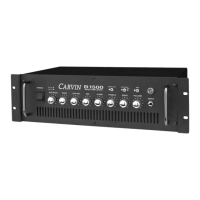HELPFUL HINTS
1) NO SOUND FROM AMP: The MUTE function has been inadvertently engaged, speakers
have been improperly connected or Effect Loop has been improperly connected.
2) NO HIGH FREQUENCIES: Tweeters or midrange drivers have been damaged from too
much power.
3) WEAK BASS: The speaker systems are wired out of phase to each other. To correct,
reverse the wires on one of the speaker connectors.
4) DIR XLR HUM: Try switching the rear GND LIFT switch IN or OUT. Check for noise from
external effects or bad cabling.
1. INPUT JACK
The 1/4” INPUT jack accommodates both passive and active instruments. The high imped-
ance Class A input stage offers enough headroom to perform without clipping even when used
with high output active basses. Input gain is adjusted with the DRIVE control (6) and the ACTIVE
INPUT switch (5).
2. VOLUME CONTROL
The VOLUME control adjusts the output level to the speakers. Adjusting the DRIVE control
will also change your output level.
3. MUTE SWITCH / LED
The MUTE switch will stop all output signals with the exception of the TUNER and EFFECT
SEND signals. The MUTE function can also be remotely controlled from the rear FOOTSWITCH
jack using the optional FS-22 footswitch. The blue LED next to the MUTE switch will light when-
ever the amp is muted. The footswitch will have no effect if the front panel MUTE switch is
on in the UP position.
4. CLIP LED
The red CLIP LED indicates that the input is near clipping. Since the B1500/B500 preamp is
designed with several Class A input gain stages and the ability to be overdriven, the CLIP LED
monitors only the first input stage and will not indicate when the DRIVE control is set to over-
drive the preamp. To avoid input clipping, reduce the bass level or reduce the output level of
devices placed between the bass and the input jack.
5. ACTIVE INPUT SWITCH / LED
The ACTIVE INPUT switch is used to match the input gain of the amp to instruments that
contain active electronics. If the preamp is being prematurely overdriven, flip the ACTIVE INPUT
switch to the ON position. If the output of your bass is low and you are not getting enough
volume from the speakers, be sure the ACTIVE INPUT switch is OFF and increase the DRIVE
control. The blue LED indicates that the ACTIVE INPUT mode is ON.
6. DRIVE CONTROL
The DRIVE control adjusts the input gain to the preamp and the level of harmonics in the
signal. With the DRIVE control set low, both input gain and harmonics are at a minimum for
clean output. Increasing the DRIVE control causes the Class A gain stages to introduce more
harmonics resulting in a rich sound typical of vintage tube amps. With the DRIVE control set
near maximum, overdrive sounds can be produced. The DRIVE control can be used with the
ACTIVE INPUT switch to get the sound you want. To reduce preamp overdrive while retain-
ing the harmonics of a high DRIVE level setting, turn the ACTIVE INPUT switch ON or reduce
the level on the bass guitar. Turning the ACTIVE INPUT switch OFF will make the preamp over-
drive easier.
7. TONE CONTROLS
The six TONE CONTROLS on the B500/B1500 are designed with the center frequencies most
requested by professional bass players. To start, set each control at its center flat position (no
tones are cut or boosted). Raise or reduce each control to get your desired tone.
The SUB BASS control is centered at 30Hz.
The BASS control is centered at 100Hz.
The LO MID control is centered at 300Hz.
The MID control is centered at 1kHz.
The HI MID control is centered at 3kHz.
The TREBLE control is centered at 10kHz.
8. EFFECT LOOP SWITCH / LED
The EFFECT LOOP switch engages the rear effects loop connections. The effects loop can
be turned on with the EFFECT LOOP switch on the front panel or by using the optional FS22
footswitch. When the front panel switch is in the UP position, the loop is engaged regardless
of the footswitch. The status of the effects loop is indicated on the front panel by the BLUE
LED next to the EFFECT LOOP switch.
See EFFECT LOOP SEND/RETURN JACKS #13.
9. AMP CLIP LED
The AMP CLIP LED indicates that the power amp is being driven too hard.
Reduce the
volume level.
10. PROTECT LED
The PROTECT LED indicates that the power amp has gone into one of it’s protect modes.
11. POWER SWITCH / (PROTECT RESET)
Push the upper portion of the POWER SWITCH to turn the amplifier on. If the large blue
power indicator is on but no sound is coming out of the speakers, the amp may have gone
into one of its protection modes. To reset the amp, turn the power off for 30 seconds and then
turn the amp back on. If the problem persists, check for; a) The speaker impedance is too low
for the amp, b) bad speaker cable, c) damaged speaker or, d) blocked rear fan intake.
1
FRONT PANEL CONTROLS
2
3
4
5
6
7
8
9
10
11

